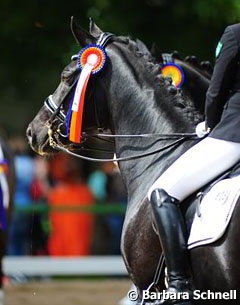
The Wiesbaden dressage show usually attracts not only a comparatively large number of starters, but also a high quality field of riders to compete in front of the most beautiful façade of the city's castle. This year there was only one Grand Prix class on Saturday which acted as the qualifier for both the Special and Freestyle tour.
The weather remained dry and around noon, just before the class kicked off at 2.30 pm, the sun came out and the temperatures — for once — reminded of an upcoming summer. The extensive castle park of Wiesbaden filled with countless visitors of all ages. The warm-up arena behind the dressage ring looked a bit like an outdoor pool with so many people sitting on blankets in the grass and observing horse and riders preparing for the class. Dressage becomes one big family picnic as Wiesbaden's unique infrastructure makes it possible.
It is quite incredible how Isabell Werth always manages to maneuver Don Johnson's exuberant and really cheeky temperament into the right lane when it counts the most: in the competition. Also at Wiesbaden the Hanoverian executed his "dance" this way: starting out on his hind-legs in the warm-up, which caused a few spectators to complain loudly, but then more tempered and under control in the show ring.
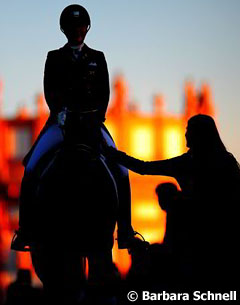 In the Grand Prix the 12-year-old Hanoverian gelding behaved well, although Werth rode the first extended trot maybe a bit carefully. For a long time the trot half-passes of Werth's horses are a hallmark of her training and Don Johnson is no exception, showing very rhythmic and smooth strides, crossing widely. The halt before the rein-back was not 100% closed behind, but the rein-back itself was very submissive and scored between 7 and 8,5. The second extended trot was expressive and full of energy. Nonetheless the overtrack was not sufficient and the judges were not quite in unison, awarding it 7 and 8. In the passage the gelding shows very even and elevated steps with pronounced suspension. The piaffes were very diligent, active and in place and Don Johnson does them with ease, but there is no real lowering of the croup and the neck is not constantly the highest point in this movement. The transitions from passage to piaffe and vice versa are outstanding and like a metronome. Werth's current top horse showed one of the best collected walks of the class after a satisfying extended walk which was regular and relaxed, but lackinf in over-track. As one of only a handful of horses the compact Hanoverian was able to show a smooth and clean transition from the collected walk to passage. In the tempi changes Don Johnson made two mistakes in the one-times after faultless two-times. The extended canter was seen quite differently by the judges and got marks between 7,5 and 9. Points were lost in the canter pirouettes which both were not what the horse is able to show. The last diagonal was on the same high level like the rest of the ride with the horse still full of energy. Her score of 75.213% was enough to win this class.
In the Grand Prix the 12-year-old Hanoverian gelding behaved well, although Werth rode the first extended trot maybe a bit carefully. For a long time the trot half-passes of Werth's horses are a hallmark of her training and Don Johnson is no exception, showing very rhythmic and smooth strides, crossing widely. The halt before the rein-back was not 100% closed behind, but the rein-back itself was very submissive and scored between 7 and 8,5. The second extended trot was expressive and full of energy. Nonetheless the overtrack was not sufficient and the judges were not quite in unison, awarding it 7 and 8. In the passage the gelding shows very even and elevated steps with pronounced suspension. The piaffes were very diligent, active and in place and Don Johnson does them with ease, but there is no real lowering of the croup and the neck is not constantly the highest point in this movement. The transitions from passage to piaffe and vice versa are outstanding and like a metronome. Werth's current top horse showed one of the best collected walks of the class after a satisfying extended walk which was regular and relaxed, but lackinf in over-track. As one of only a handful of horses the compact Hanoverian was able to show a smooth and clean transition from the collected walk to passage. In the tempi changes Don Johnson made two mistakes in the one-times after faultless two-times. The extended canter was seen quite differently by the judges and got marks between 7,5 and 9. Points were lost in the canter pirouettes which both were not what the horse is able to show. The last diagonal was on the same high level like the rest of the ride with the horse still full of energy. Her score of 75.213% was enough to win this class.
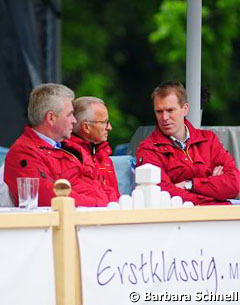 Werth ranked first ahead of another A-team rider, Fabienne Lütkemeier with her long-time partner D'Agostino. The tall Lütkemeier rode her best Grand Prix-horse in Wiesbaden. The leggy and clearly blood influenced D'Agostino had been a double European Young Riders champion in 2010 and then had made a successful transition to Grand Prix a few years ago. The horse's forté is clearly the trot tour in which the Hanoverian's natural lightfootedness is a real advantage. Accordingly the extended trots were all three very fluent and full of impulsion, but the horse should come in front of the vertical which might explain why for example the last trot extension was marked between 7,5 and 9. The trot half-passes are very elegant because the De Niro-offspring crosses widely with his long legs and moves very smoothly. The passage had significantly improved compared to last season. The horse bounces much more and the suspension is longer. Unfortunately D'Agostino's piaffe has not equally improved. The horse tries hard and is diligent, but he still leans too much on the forehand instead of taking most of the weight behind and lifting the withers. The extended walk was good which also can be said of both flying changes in which the liver chestnut very fluently changed leads and never lost the forward tendency. A real highlight was the courageously ridden and uphill extended canter.
Werth ranked first ahead of another A-team rider, Fabienne Lütkemeier with her long-time partner D'Agostino. The tall Lütkemeier rode her best Grand Prix-horse in Wiesbaden. The leggy and clearly blood influenced D'Agostino had been a double European Young Riders champion in 2010 and then had made a successful transition to Grand Prix a few years ago. The horse's forté is clearly the trot tour in which the Hanoverian's natural lightfootedness is a real advantage. Accordingly the extended trots were all three very fluent and full of impulsion, but the horse should come in front of the vertical which might explain why for example the last trot extension was marked between 7,5 and 9. The trot half-passes are very elegant because the De Niro-offspring crosses widely with his long legs and moves very smoothly. The passage had significantly improved compared to last season. The horse bounces much more and the suspension is longer. Unfortunately D'Agostino's piaffe has not equally improved. The horse tries hard and is diligent, but he still leans too much on the forehand instead of taking most of the weight behind and lifting the withers. The extended walk was good which also can be said of both flying changes in which the liver chestnut very fluently changed leads and never lost the forward tendency. A real highlight was the courageously ridden and uphill extended canter.
In the first canter pirouette the gelding did not jump behind, but rather turned; the second was better. The last diagonal was on the same level like the piaffes and passages before and the horse's will to go never faded until the final halt.
With 74,553% both were not that far away from the leaders.
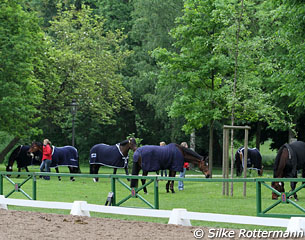 Danish combination Lone Bang-Larsen and Fitou L continued their very good form at Wiesbaden after making a strong international come back in Hagen in April. With 72.553% they finished a remarkable third. Now 14, this strong boned Danish warmblood gelding had already left an impression at the 2004 and 2005 World Championships in Verden as a young horse. Sired by Florestan I out of a mare by May Sherif, Fitou L impressed in general with his ability for collection. In Wiesbaden he began his round with a very energetic first extended trot which tended to look almost hasty. The trot half-passes had lots of impulsion, but could be a bit more bent. The horse showed one of the best halts before the rein-back which unfortunately became a bit askew and the horse got too deep. The first piaffe revealed the bay's strong point, his ability to sit on his hind-legs in the collected movements. The piaffe was very settled and active, but still slightly on the forehand which was also shown by the slight bopping of the horse's head. The extended walk was satisfying with good stretching of the top-line. The passage after the collected walk was very impulsive, but the suspension should be more pronounced and the movement itself executed slowlier. The second piaffe was even better than the first, very elastic, diligent and active in the hind-legs, the horse carrying himself and being better off the forehand. Lone Bang Larsen rode the two-time changes forward and the same can be said about the extended canter which lost the uphill tendency at the end due to this created energy. Generally it seems a problem that horses lose the uphill stride when being pushed too much in the canter extensions. Regrettably the tricky zig-zag half-passes in canter didn't remain faultless, but Fitou L made up for it with very nice changes. Each stride was of the same length and uphill, the horse completely in balance. Both pirouettes were executed with nice sit, but sometimes the clear canter rhythm seemed interrupted. On the final diagonal the horse still had lots of energy left to show an expressive passage, though the left hind-legs stepped a bit more under than the right one. The last piaffe was again very active and only slightly forwards. All in all a classy and fairly harmonious ride which showed what an unbelievably strong pool of riders Denmark has for the upcoming European Championships on home turf in Herning. It will be super exciting not only to see who will be chosen for the team by Rudolf Zeilinger, but also how the Danish team will do in the nations' cup.
Danish combination Lone Bang-Larsen and Fitou L continued their very good form at Wiesbaden after making a strong international come back in Hagen in April. With 72.553% they finished a remarkable third. Now 14, this strong boned Danish warmblood gelding had already left an impression at the 2004 and 2005 World Championships in Verden as a young horse. Sired by Florestan I out of a mare by May Sherif, Fitou L impressed in general with his ability for collection. In Wiesbaden he began his round with a very energetic first extended trot which tended to look almost hasty. The trot half-passes had lots of impulsion, but could be a bit more bent. The horse showed one of the best halts before the rein-back which unfortunately became a bit askew and the horse got too deep. The first piaffe revealed the bay's strong point, his ability to sit on his hind-legs in the collected movements. The piaffe was very settled and active, but still slightly on the forehand which was also shown by the slight bopping of the horse's head. The extended walk was satisfying with good stretching of the top-line. The passage after the collected walk was very impulsive, but the suspension should be more pronounced and the movement itself executed slowlier. The second piaffe was even better than the first, very elastic, diligent and active in the hind-legs, the horse carrying himself and being better off the forehand. Lone Bang Larsen rode the two-time changes forward and the same can be said about the extended canter which lost the uphill tendency at the end due to this created energy. Generally it seems a problem that horses lose the uphill stride when being pushed too much in the canter extensions. Regrettably the tricky zig-zag half-passes in canter didn't remain faultless, but Fitou L made up for it with very nice changes. Each stride was of the same length and uphill, the horse completely in balance. Both pirouettes were executed with nice sit, but sometimes the clear canter rhythm seemed interrupted. On the final diagonal the horse still had lots of energy left to show an expressive passage, though the left hind-legs stepped a bit more under than the right one. The last piaffe was again very active and only slightly forwards. All in all a classy and fairly harmonious ride which showed what an unbelievably strong pool of riders Denmark has for the upcoming European Championships on home turf in Herning. It will be super exciting not only to see who will be chosen for the team by Rudolf Zeilinger, but also how the Danish team will do in the nations' cup.
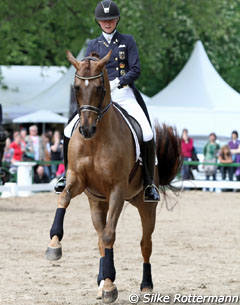 After only one show at Under 25 level with her new ride Favourit, Sanneke Rothenberger made the move to the senior league in Wiesbaden and accomplished quite a feat by finishing fourth in such a big and strong field against much more seasoned competitors. Young Sanneke Rothenberger took her stand with the experienced Westfalian gelding (by Fidermark I x Worldchamp) which her parents acquired from Tinne Vilhemsson-Silfven as a proven championship horse. The cute compact liver chestnut and the leggy Sanneke already look like an established pair and obviously have clicked from the beginning. The silhouette looks very similar to the one the Swede formed with the gelding and this is also valid for the frame in which the horse is presented. The whole trot tour was of good quality. In the extensions the horse should come more in front of the vertical. The half passes were fluent on both leads, but Favourit came too deep and tight. The first piaffe's beginning was slightly delayed until the horse found the rhythm and showed more active steps, but he should be more open in the neck and not so deep. The passage is good with Favourit swinging through his whole body and keeping the rhythm. The second one was differently marked between 7 and 9. The extended walk was not shown with much over-track, but it was relaxed and with nice stretching. Both tempi changes were faultless with the one-times really nice and forward and the rider sitting smoothly and with the movement. The highlight of the ride were the canter pirouettes. The Westfalian executed them almost on the spot, deep on his haunches and with an absolute eveness of each single stride. Sanneke Rothenberger and Favourit, observed like all listed German riders by Monica Theodorescu, surely left a very positive impression, let alone considering the short time they are together and the fact that the rider only returned home from a semester in Canada a few weeks ago.
After only one show at Under 25 level with her new ride Favourit, Sanneke Rothenberger made the move to the senior league in Wiesbaden and accomplished quite a feat by finishing fourth in such a big and strong field against much more seasoned competitors. Young Sanneke Rothenberger took her stand with the experienced Westfalian gelding (by Fidermark I x Worldchamp) which her parents acquired from Tinne Vilhemsson-Silfven as a proven championship horse. The cute compact liver chestnut and the leggy Sanneke already look like an established pair and obviously have clicked from the beginning. The silhouette looks very similar to the one the Swede formed with the gelding and this is also valid for the frame in which the horse is presented. The whole trot tour was of good quality. In the extensions the horse should come more in front of the vertical. The half passes were fluent on both leads, but Favourit came too deep and tight. The first piaffe's beginning was slightly delayed until the horse found the rhythm and showed more active steps, but he should be more open in the neck and not so deep. The passage is good with Favourit swinging through his whole body and keeping the rhythm. The second one was differently marked between 7 and 9. The extended walk was not shown with much over-track, but it was relaxed and with nice stretching. Both tempi changes were faultless with the one-times really nice and forward and the rider sitting smoothly and with the movement. The highlight of the ride were the canter pirouettes. The Westfalian executed them almost on the spot, deep on his haunches and with an absolute eveness of each single stride. Sanneke Rothenberger and Favourit, observed like all listed German riders by Monica Theodorescu, surely left a very positive impression, let alone considering the short time they are together and the fact that the rider only returned home from a semester in Canada a few weeks ago.
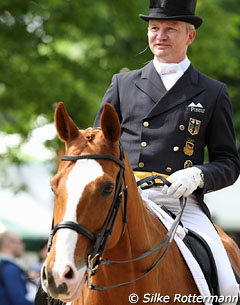 A familiar pair, reunited, slotted into 5th place: Hubertus Schmidt and the now 12-year-old Westfalian gelding Donnelly. They were a promising pair a few years ago, before Schmidt's bereiter Emma Kanerva took him over. The colored chestnut had not been shown for a while, but at Wiesbaden Donnelly proved that he has not forgotten anything. The extended trots were energetic and expressive, the trot half passes in very good rhythm and bending. The first and the last passage showed a few irregular steps whereas the second was really good. The gelding's first piaffe was fairly in place and rhythmical with good lowering of the haunches, but the horse should show more expression and intrinsic activity. Donnelly improved on this in the other piaffes. Schmidt tried to influence his equine partner's extended walk positively by holding the hands quite wide apart, still it were rather short strides which cost points. Both tempi changes were very safe and in particular the one-times were nicely forward and with very even strides. In the last extended trot it became visible that Hubertus Schmidt had to work in the saddle to keep the Westfalian going. The pair is definitely a welcome addition to the German dressage pool.
A familiar pair, reunited, slotted into 5th place: Hubertus Schmidt and the now 12-year-old Westfalian gelding Donnelly. They were a promising pair a few years ago, before Schmidt's bereiter Emma Kanerva took him over. The colored chestnut had not been shown for a while, but at Wiesbaden Donnelly proved that he has not forgotten anything. The extended trots were energetic and expressive, the trot half passes in very good rhythm and bending. The first and the last passage showed a few irregular steps whereas the second was really good. The gelding's first piaffe was fairly in place and rhythmical with good lowering of the haunches, but the horse should show more expression and intrinsic activity. Donnelly improved on this in the other piaffes. Schmidt tried to influence his equine partner's extended walk positively by holding the hands quite wide apart, still it were rather short strides which cost points. Both tempi changes were very safe and in particular the one-times were nicely forward and with very even strides. In the last extended trot it became visible that Hubertus Schmidt had to work in the saddle to keep the Westfalian going. The pair is definitely a welcome addition to the German dressage pool.
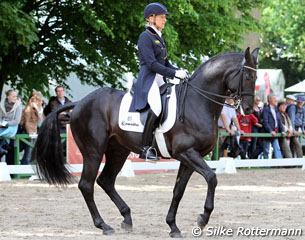 Sixth place was shared by Germany's multi-talented Ingrid Klimke and Portugal's dressage star Gonçalo Carvalho who both had exactly the same percentage: 70.851%. Ingrid Klimke and her rising Grand Prix youngster Dresden Mann (by Dresemann) were the second starters in a field of 28. The 9-year old Westfalian was the youngest horse in the Grand Prix and was quite impressed by the Wiesbaden dressage arena and its atmosphere with the big tribune and the packed stands at the short sides. Klimke not only had a busy day as only an hour before she had won the international eventing competition, but also had to deal with the unexpected death of her Olympic team mate Dirk Schrade's King Artus at the end of the cross-country. However, she handled the situation professionally and presented her hot Westfalian with lots of skill. In the extended trots Klimke had the hand brake on: Alfi's tail revealed that he was a bit tense. Still the rein-back was fluent and obediently executed. His piaffes are already world-class and of rare light-footedness, sitting on his haunches and simply playing with this demanding movement. On the other hand the transitions from piaffe into passage are still work in progress with Dresden Mann having trouble to keep the rhythm, but this might just be a case of strength. The passage is of similar expression and lightness like the piaffe, with prominent suspension, though the hind legs could push more from behind. The two time changes were faultless, but still not 100% straight whereas in the one-times Dresden Mann made a mistake. Klimke wasn't able to risk a lot in the extended canter as her horse was still quite fresh. Although both had already scored higher this season than the 70.438% in Wiesbaden, this pair is one to watch for the future.
Sixth place was shared by Germany's multi-talented Ingrid Klimke and Portugal's dressage star Gonçalo Carvalho who both had exactly the same percentage: 70.851%. Ingrid Klimke and her rising Grand Prix youngster Dresden Mann (by Dresemann) were the second starters in a field of 28. The 9-year old Westfalian was the youngest horse in the Grand Prix and was quite impressed by the Wiesbaden dressage arena and its atmosphere with the big tribune and the packed stands at the short sides. Klimke not only had a busy day as only an hour before she had won the international eventing competition, but also had to deal with the unexpected death of her Olympic team mate Dirk Schrade's King Artus at the end of the cross-country. However, she handled the situation professionally and presented her hot Westfalian with lots of skill. In the extended trots Klimke had the hand brake on: Alfi's tail revealed that he was a bit tense. Still the rein-back was fluent and obediently executed. His piaffes are already world-class and of rare light-footedness, sitting on his haunches and simply playing with this demanding movement. On the other hand the transitions from piaffe into passage are still work in progress with Dresden Mann having trouble to keep the rhythm, but this might just be a case of strength. The passage is of similar expression and lightness like the piaffe, with prominent suspension, though the hind legs could push more from behind. The two time changes were faultless, but still not 100% straight whereas in the one-times Dresden Mann made a mistake. Klimke wasn't able to risk a lot in the extended canter as her horse was still quite fresh. Although both had already scored higher this season than the 70.438% in Wiesbaden, this pair is one to watch for the future.
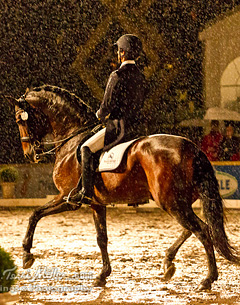 The more experienced Lusitano stallion Rubi (by Batial x Xaquiro) has already made its mark at past international championships with his rider Gonçalo Carvalho from Portugal. The now 15-year-old is a typical modern representative of his country's breed with a massively muscled neck and a comparatively light body. Rubi's obvious strong spots are the piaffe and passage. The former complies with almost all requirements of this movement: executed in place, active, visibly lowered croup and haunches. Only Rubi's neck should be a bit higher and more open open. The passage is very regular. There was excellence in the trot half-passes in which the seasoned stallion became very light in the contact. The extended trots did show little over-track with the horse rather becoming faster than lengthening the strides. Rubi's weak spot seems to be the extended walk in which he showed short steps. The horse's downfall in this class came in the flying changes: the two-times were started as 3-time changes and then mistakes in the one times followed. Unfortunately the horse broke into canter for a short moment on the final diagonal before he picked up the required passage which cost even more points. Both redeemed themselves in the freestyle in which they danced to a second place behind Isabell Werth and Der Stern OLD.
The more experienced Lusitano stallion Rubi (by Batial x Xaquiro) has already made its mark at past international championships with his rider Gonçalo Carvalho from Portugal. The now 15-year-old is a typical modern representative of his country's breed with a massively muscled neck and a comparatively light body. Rubi's obvious strong spots are the piaffe and passage. The former complies with almost all requirements of this movement: executed in place, active, visibly lowered croup and haunches. Only Rubi's neck should be a bit higher and more open open. The passage is very regular. There was excellence in the trot half-passes in which the seasoned stallion became very light in the contact. The extended trots did show little over-track with the horse rather becoming faster than lengthening the strides. Rubi's weak spot seems to be the extended walk in which he showed short steps. The horse's downfall in this class came in the flying changes: the two-times were started as 3-time changes and then mistakes in the one times followed. Unfortunately the horse broke into canter for a short moment on the final diagonal before he picked up the required passage which cost even more points. Both redeemed themselves in the freestyle in which they danced to a second place behind Isabell Werth and Der Stern OLD.
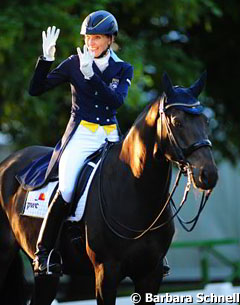 The ranking between spot 8 to 12 was quite close. Scandinavian girls Cecilia Dorselius with the elegant Westfalian Lennox (by Laurentianer x Florestan I) came 8th while Norwegian Catherine Rasmussen rode Olympic champion Charlotte Durjardin's first Grand Prix horse Fernandenz, another Westfalian (by Florestan I) to 9th position.
The ranking between spot 8 to 12 was quite close. Scandinavian girls Cecilia Dorselius with the elegant Westfalian Lennox (by Laurentianer x Florestan I) came 8th while Norwegian Catherine Rasmussen rode Olympic champion Charlotte Durjardin's first Grand Prix horse Fernandenz, another Westfalian (by Florestan I) to 9th position.
Uta Gräf from Germany showed her second Grand Prix horse Dandelion (by De Niro) for the first time at CDI-level and came 10th with the big framed gelding, whereas Jenny Lang, third placed in the Grand Prix at 2013 CDI Mannheim a fortnight earlier, had to be content with an 11th place this time.
The sun, which shone on the horses and riders on that Wiesbaden afternoon, disappeared after the Grand Prix. The freestyle under floodlights on Saturday night, which is always a true highlight, suffered from heavy rainfall and very cold temperatures. Horses and riders fought through increasingly deeper puddles in the arena. Some horses utterly detested the unusual conditions and did not perform to their ususal ability. Isabell Werth motivated her Oldenburger gelding Der Stern OLD (by Sion) to win the class. Portugal's Gonçalo Carvalho and Rubi came second and Ingrid Klimke piloted Dresden Mann to a third. Unfortunately the weather got worse and on Sunday all scheduled dressage competitions, including the Grand Prix Special, were cancelled which not only was a pity for the riders who had chosen to compete there, but also for the dressage fans at Wiesbaden.
Text by Silke Rottermann
Photos © Silke Rottermann - Barbara Schnell - Terri Miller
Related Links
Scores: 2013 CDI Wiesbaden
Uta Graf and Damon Jerome Dominate 2013 CDI Wiesbaden Prix St Georges